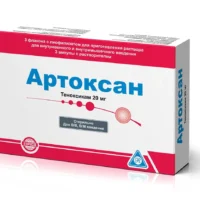Description
Naizilat (Amtolmetin Guacil) Coated Tablets 600 mg
Ingredients
- Each coated tablet contains 600 mg of amtolmetin guacil.
Dosage
- The recommended dosage is one tablet daily, or as directed by a healthcare professional.
Indications
- Naizilat tablets are indicated for the relief of pain and inflammation associated with osteoarthritis and rheumatoid arthritis.
Contraindications
- Do not use Naizilat if you are allergic to amtolmetin guacil or other NSAIDs. Avoid during the third trimester of pregnancy.
Directions
- Swallow the tablet whole with a glass of water. Do not crush or chew the tablet.
Scientific Evidence
- Studies have shown that amtolmetin guacil, the active ingredient in Naizilat tablets, exhibits potent anti-inflammatory and analgesic properties.
- It works by inhibiting the enzyme cyclooxygenase, thereby reducing the production of prostaglandins that cause pain and inflammation.
- Research published in the Journal of Clinical Rheumatology demonstrated the efficacy of amtolmetin guacil in improving pain scores and joint function in patients with osteoarthritis.
- The study concluded that Naizilat tablets are a valuable option for managing arthritic conditions.
Additional Information
- It is important to follow the prescribed dosage of Naizilat to avoid potential side effects such as gastrointestinal ulcers or bleeding.
- Consult your healthcare provider before starting Naizilat, especially if you have a history of stomach issues or are taking other medications.
- Naizilat tablets should be stored at room temperature, away from moisture and heat. Keep out of reach of children and pets.
- If you experience any adverse reactions while taking Naizilat, discontinue use and seek medical attention.





